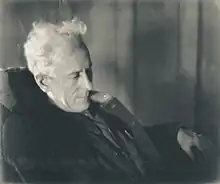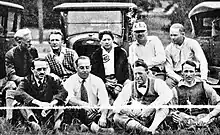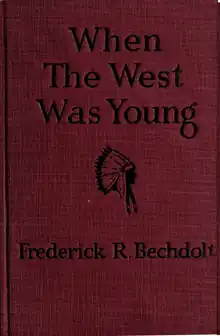Frederick R. Bechdolt
Frederick Ritchie Bechdolt (July 27, 1874 – April 12, 1950) (also known as Fred or Bech) was an American journalist, Western fiction writer,[1] and Bohemian member of the Carmel art colony. He was a prolific writer, publishing over 30 books and countless articles in his lifetime.[2][3][4]
Frederick R. Bechdolt | |
|---|---|
 Bechdolt ca. 1925 | |
| Born | Frederick Ritchie Bechdolt July 27, 1874 Mercersburg, Pennsylvania, U.S. |
| Died | April 12, 1950 (aged 75) Carmel-by-the-Sea, California, U.S. |
| Occupation | Journalist |
| Notable works | 9009 When the West Was Young |
Early life
Bechdolt was born on July 27, 1874, in Mercersburg, Pennsylvania.[2][3] He was the son of Adolph F. Bechdolt (1846–1938) and Jean Ritchie (1845–1896).[5] He went to University of North Dakota (1892–1895), and received his Bachelor of Arts at the University of Washington in 1896, where his father was a German professor. Bechdolt was captain of the first football team at University of North Dakota, in 1894. His father was the team's head coach.[6] His younger brother, Jack (1884–1954), also became a noted journalist and writer.[7]
Bechdolt married Adele V. Fortier (Hale) (1873–1945) on December 9, 1938. Adele (Dickie) had two children during her previous marriage.[1] to Lester Marsh Hale (1869–1941), Donald Lester Hale who married Alice Hilby and Bonnie Hale, who married Carmel builder Lee Gottfried (1896–1968).[8] Adele's sister was Kathryn (Kittie) Jane Fortier (1879–1932) who married William Lorenzo Overstreet (1871–1941), founder of The Carmel Pine Cone.[3][5]
After college, in 1897, Bechdolt went on a series of adventures that included becoming a placer miner in the Klondike Gold Rush where he drove a dog sled on the Chikoot and White Pass trails.[2][4] He spent time in Death Valley and the Mojave Desert, where he lived on and a ranch and explored mines. In Washington, he helped drill the Cascade Tunnel for the railroad. He used many of these experiences to write his Western stories.[1]
Career

Bechdolt was a prolific writer, publishing over 30 books and countless articles in his lifetime. His writing covered a wide range of topics, from travel and adventure to Western stories. These stories were published in McClure's, Collier's, The Saturday Evening Post, and The Popular Magazine.[1]
In 1900, Bechdolt became a journalist and worked as a reporter for The Seattle Star, Los Angeles Times, and The San Francisco Call. He did research at San Quentin State and Alcatraz prisons and took up the cause for prisoners' rights.[1][9]
In 1906, he was one of the earliest writers to visit Carmel-by-the-Sea, California. This is where he met writer James Hopper and the two became good friends, often entertaining with some of Carmel's bohemians like musician Mabel Gray Lachmund.[10] Bechdolt and his wife moved to Carmel in 1907, and built a home in the Eighty Acres tract of Carmel where he was a neighbor of writer George Sterling. Together, Bechdolt and Hopper wrote the fictional novel 9009 (1908) about the condition of American prisons and the need for reform.[1][11][9] Following the publication of his novel 9009, he went on to write The Hard Rock Man. Initially, it appeared as a short story in the Saturday Evening Post in 1908 and was later serialized as "Tom Morton: A Story of the Hard Rock Men" in the same publication in 1910. The majority of his fictional works, including Tales of the Old-timers (1924), revolved around exhilarating adventures set in the Old West, particularly in Texas, with a focus on the aftermath of the Alamo incident. His short stories, often centered around similar themes, consistently found their place in esteemed magazines like the Saturday Evening Post.[4]

Bechdolt played a role as one of the founding members of the Forest Theater Guild. In July 1915, Bechdolt played Father Serra in Perry Newberry's play Junípero Serra at the Forest Theater, a historical pageant focusing on the life of Junípero Serra. The play was a big success and was performed again at the Panama–Pacific International Exposition. He was an actor in other plays, including The Brink Of Silence, (1925) and The Thrice Promised Bride (1923).[12][3][13][14]
Bechdolt was an early member of Carmel's Abalone League, along Edward Kuster, Charley Van Riper, James Hopper, John Hillaiard, Ernest Schweninger, Talbert Josselyn, R. C. Smith, and Winsor Josselyn.[15]
Bechdolt actively backed Perry Newberry's endeavors to safeguard Carmel from unchecked development. He also contributed his service as a member of the city council on two separate occasions. In the midst of the Great Depression, Bechdolt took charge of the local office of the WPA Federal Writers' Project, leading the group in crafting the renowned Monterey Peninsula Guide. He took on the role of acting postmaster initially and later assumed the position of police commissioner.[4][9][3]
After World War II, Bechdolt collaborated with fellow writers such as Robinson Jeffers and John Steinbeck to oppose discriminatory attempts aimed at obstructing the repatriation of Japanese American citizens who had been interned, ensuring their rightful return to Monterey County.[4] Bechdolt's book Riot at Red Water (1944) was a book listed in the List of Armed Services Editions, which were small paperback books of fiction and nonfiction that were distributed in the American military during World War II.[16]
Death
Bechdolt died at the Carmel Cumminity hospital on April 12, 1950, at the age of 75. Funeral services were held at the T. A. Dorney Funeral Chapel in Monterey and Requiem mass at the Carmel Mission.[2]
Legacy
Bechdolt's legacy as a writer and adventurer endures to this day. His books are still in print, and his spirit of adventure and exploration continues to inspire new generations of travelers and adventurers.[2] Several books have been turned into films, including The Pot o' Gold (1917), The Hard Rock Breed (1918), and Thieves' Gold (1918).[17]
Works

- 9009 (1908) (with James Hopper)
- The Hard Rock Man (1910)
- When The West Was Young (1922, "Century") fact-based stories:
- How Death Valley Was Named
- Joaquin Murieta
- Tombstone
- Tombstone's Wild Oats
- The Show-Down
- The Passing Of John Ringo
- John Slaughter's Way
- Cochise
- One Against Many
- The Overland Mail
- Boot-Hill
- The Pot o' Gold (1917
- Thieves' Gold (1918)
- The Hard Rock Breed (1918)
- Tales of the Old-timers (1924)
- The Warriors of the Pecos
- The Warriors of the Canadian
- The Law-Bringers
- Tascosa
- Adobe Walls
- Red Blood and White
- The First Cowboy
- The Forgotten Expedition to Santa Fé
- The Texans
- The Most Consummate Villain
- Cassidy and the Wild Bunch
- The Last of the Open Ranges
- Mutiny: an Adventure Story (1927, Chelsea House)
- Giants of the Old West (1930)
- Riders of San Pedro (1931)
- Horse Thief Trail (1932)
- The Tree of Death (1937)
- Danger On The Border (1940)[18]
- Riot at Red Water (1944)[16]
Works from periodicals
- The Hard Rock Man (short story) (1910)
- Tom Morton A Story of the Hard-Rock Men (1910, Saturday Evening Post) serial
- Sand (1910, Saturday Evening Post) article
- Flanagan's Stool-Pigeon (1912, McClure's)
- The Clubhauling of Monohan (1912 Oct, Red Book)
- Tim the Grappler (1912 Nov, Red Book)
- The Keelhauling of Fat Dan (1912 Dec, Red Book)
- Gold and Two Men (1913 Feb, Red Book)
- The Sureness of MacKenzie (1923 Jan, Sea Stories)
- The Way Out (1923 May, Red Book)
- The Case of Mimbres (1924 Mar, Blue Book)
- For the Sake of Business (1924 Mar, Red Book)
- Sheriff Jack Flood (1924 Apr, Cosmopolitan)
- Mogollon's Partners (1924 May, Blue Book)
- Brazos (1924 Aug, Cosmopolitan)
- A Son-in-Law With Sand (1924 Oct, Cosmopolitan)
- The Soft Side of Hate (1924 Nov, Cosmopolitan)
- Lighthouse Tom (1912) stories
- The Romance of Lighthouse Tim (1912 Mar, Red Book)
- Before Michael Came (1912 Apr, Red Book)
- Red Larson's Account (1912 May, Red Book)
- Sealed Orders (1912 June, Red Book)
- The Piracy of Black Scotty (1912 July, Red Book)
- An Epic of the Windjammers (1912 Aug, Red Book)
- The Passing of Black Jack (1912 Sept, Red Book)
Non-fiction
- One Against Many (1921 Mid-June, Adventure)
- Cochise (1921 July 1, Adventure)
- The First Cowboy (1922 Nov 30, Adventure)
References
- Dramov, Alissandra (2012). Carmel-by-the-Sea, the Early Years (1903–1913). pp. 143–144. ISBN 9781491824146. Retrieved March 5, 2023.
{{cite book}}:|work=ignored (help)CS1 maint: location missing publisher (link) - "Bechdolt Services To Be Tomorrow At Carmel Mission". The Californian. Salinas, California. April 14, 1950. p. 2. Retrieved March 5, 2023.
- Hale, Sharron Lee (1980). A tribute to yesterday: The history of Carmel, Carmel Valley, Big Sur, Point Lobos, Carmelite Monastery, and Los Burros. Santa Cruz, California: Valley Publishers. pp. 45, 50–51. ISBN 9780913548738. Retrieved January 18, 2022.
- Connie Wright (2014). "Frederick Bechdolt: One of the Carmel Bunch". Stories of Old Carmel: A Centennial Tribute From The Carmel Residents Association. p. 53.
{{cite book}}:|work=ignored (help)CS1 maint: location missing publisher (link) - "Historical Information for Frederick Ritchie Bechdolt". FamilySearch. Retrieved March 5, 2023.
- "2022 North Dakota Football Media Guide" (PDF). University of North Dakota. pp. 95, 97, 127. Retrieved March 26, 2023.
- "Pioneer Educator Resigns After Nineteen Years of Service at Whatcom High School". The Bellingham Herald. Bellingham, Washington. May 3, 1923. p. 1. Retrieved March 26, 2023 – via Newspapers.com
 .
. - "Lee Gottfried Dead". Carmel-by-the-Sea, California: Carmel Pine Cone. January 1, 1968. p. 2. Retrieved March 6, 2023.
- Grimes, Teresa; Heumann, Leslie. "Historic Context Statement Carmel-by-the-Sea" (PDF). Leslie Heumann and Associates1994. pp. 15–16. Retrieved January 18, 2022.
- Seavey, Kent (2007). Carmel, A History in Architecture. pp. 30–31. ISBN 9780738547053. Retrieved January 16, 2022.
{{cite book}}:|work=ignored (help)CS1 maint: location missing publisher (link) - Hopper, James Marie; Bechdolt, Frederick Ritchie (1908). 9009. Retrieved February 28, 2022.
{{cite book}}:|work=ignored (help) - Gilliam, Harold; Gilliam, Ann (1992). Creating Carmel: the Enduring Vision. Salt Lake City: Peregrine Smith Books. p. 131. ISBN 9780879053970. Retrieved March 10, 2022.
- "Forest Theater Plays". Harrison Memorial Library. Carmel-by-the-Sea, California. 1910. Retrieved June 22, 2022.
- "Arts and Crafts Club Scrapbook". Harrison Memorial Library. Carmel-by-the-Sea, California. 1912. Retrieved June 9, 2022.
- Irene Gaasch (April 15, 1976). "Abalone League, a glorious league in Carmel's golden age". Carmel Pine Cone. Carmel-by-the-Sea, California. pp. 1, 18. Retrieved July 16, 2022.
- Frederick Ritchie Bechdolt (1942). Riot at Red Water.
{{cite book}}:|work=ignored (help) - "Frederic R. Bechdolt". IMDB. Retrieved March 6, 2023.
- "What's New at the Library, Danger On The Border". Nebraska Daily News-Press. Nebraska City, Nebraska. July 21, 1940. p. 7. Retrieved March 6, 2023.